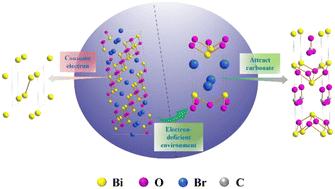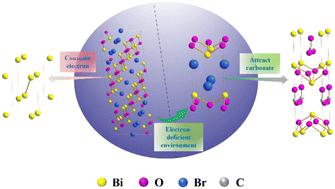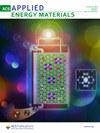Halide-guided carbon-affinity active sites in BimOnBrp-derived Bi2O2CO3 for efficient electrocatalytic CO2 reduction to formate†
IF 5.4
3区 材料科学
Q2 CHEMISTRY, PHYSICAL
引用次数: 0
Abstract
Bismuth oxyhalides (BimOnXp, where X represents Cl, Br, and I) present a promising family of template catalysts for in situ Bi2O2CO3 synthesis to achieve the highly efficient CO2 electrochemical reduction reaction (CO2RR) toward formate. However, the specific mechanism behind BimOnXps' structural reconstruction and their subsequent effects on CO2RR performance remain unresolved inquiries. In this study, a comprehensive investigation into how halogens (Cl, Br, and I) influence BimOnXp CO2RR performance was conducted. It is suggested that Br is capable of introducing a bismuth-rich phase (Bi24O31Br10) in BiOBr, which promotes the formation of external Bi–O structural characteristics and leads to exceptional CO2RR performance, with a faradaic efficiency (FEHCOO −) of 90.67% and a formate partial current density (JHCOO −) of 52.31 mA cm−2, surpassing those of BiOCl and BiOI. Kinetic simulations suggest that the alternative Bi–O structure will promote the combination of the Bi–O structure and carbon-based intermediates, leading to the improved kinetics of the rate-determining step, and ultimately resulting in better CO2RR performance.


BimOnBrp 衍生的 Bi2O2CO3 中卤化物引导的碳亲和性活性位点用于高效电催化 CO2 还原成甲酸盐
氧卤化铋(BimOnXp,其中 X 代表 Cl、Br 和 I)是一种很有前景的模板催化剂,可用于原位合成 Bi2O2CO3,以实现高效的 CO2 电化学还原反应(CO2RR)。然而,BimOnXps 结构重构背后的具体机制及其对 CO2RR 性能的后续影响仍是未解之谜。本研究对卤素(Cl、Br 和 I)如何影响 BimOnXp CO2RR 性能进行了全面调查。结果表明,Br 能够在 BiOBr 中引入富铋相(Bi24O31Br10),从而促进外部 Bi-O 结构特征的形成,并带来优异的 CO2RR 性能,其远红外效率 (FEHCOO-) 为 90.67%,甲酸盐部分电流密度 (JHCOO-) 为 52.31 mA cm-2,超过了 BiOCl 和 BiOI。动力学模拟表明,替代的 Bi-O 结构将促进 Bi-O 结构与碳基中间体的结合,从而改善速率决定步骤的动力学,最终实现更好的 CO2RR 性能。
本文章由计算机程序翻译,如有差异,请以英文原文为准。
求助全文
约1分钟内获得全文
求助全文
来源期刊

ACS Applied Energy Materials
Materials Science-Materials Chemistry
CiteScore
10.30
自引率
6.20%
发文量
1368
期刊介绍:
ACS Applied Energy Materials is an interdisciplinary journal publishing original research covering all aspects of materials, engineering, chemistry, physics and biology relevant to energy conversion and storage. The journal is devoted to reports of new and original experimental and theoretical research of an applied nature that integrate knowledge in the areas of materials, engineering, physics, bioscience, and chemistry into important energy applications.
 求助内容:
求助内容: 应助结果提醒方式:
应助结果提醒方式:


